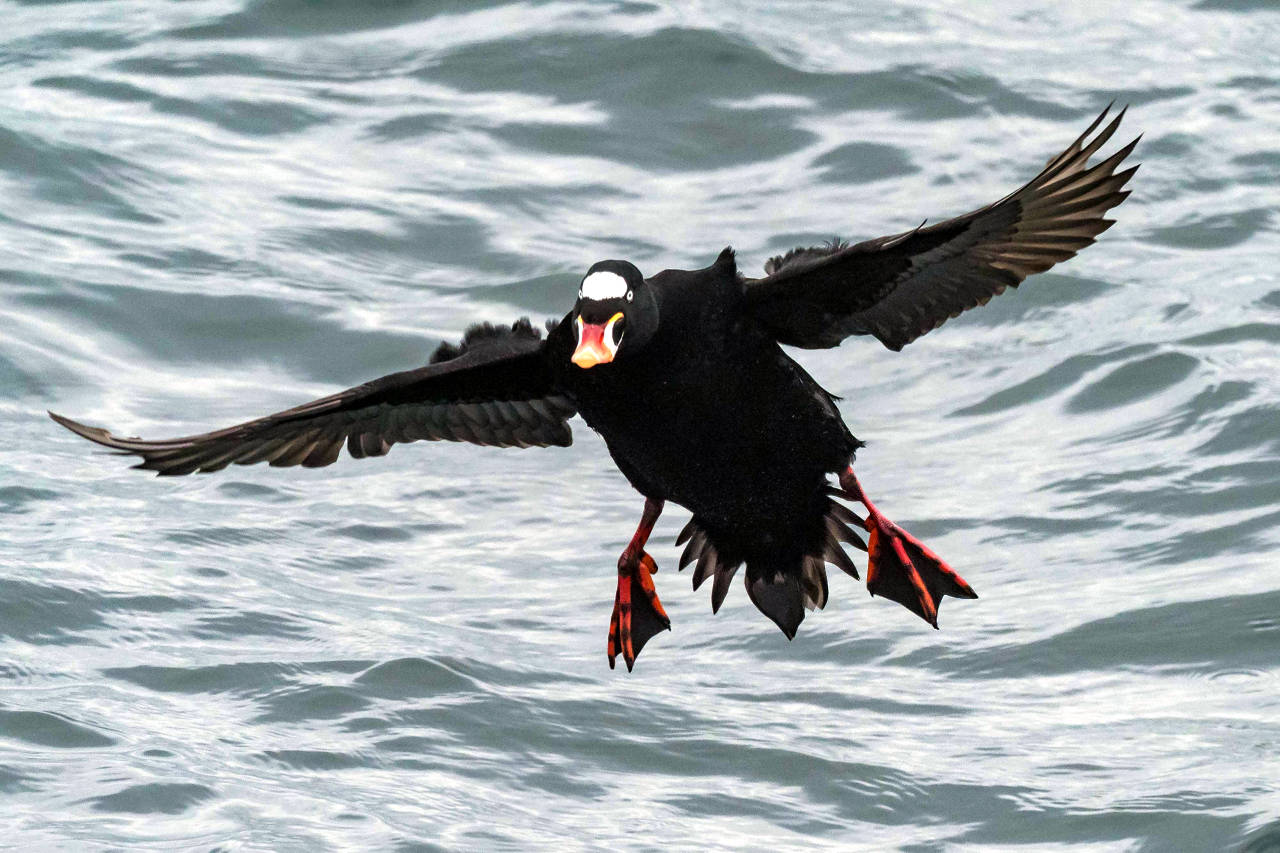By Dianna Moore
Grays Harbor Audubon
The next time you stand on the beach looking out at the waves check to see if there are duck-like birds in the rough zone of breaking waves. Chances are there are Surf Scoters out there, seemingly enjoying the ride. They are regulars here in the winter.
General Description: Surf Scoters are large sea ducks. Males are black with white patches on the forehead, the back of the head, and the base of the bill. Their serrated bill is large and very colorful, with orange, black, and white accents. Their feet are orange with black webbing. Females are mottled dark brown and white with a large black bill and white patches behind the eyes and behind the base of the bill. Both sexes have white eyes. Juveniles are similar to females but have black eyes. Both sexes are 18.9 to 23.6 inches in length with wingspans of 29.9 to 30.3 inches, and weighing 31.8 to 35.6 ounces
Habitat: Surf Scoters are most easily found during migration and winter when they settle in at the coast in shallow bays and estuaries. They nest on fresh water in the Arctic in open terrain. They may sit out bad weather on inland lakes and reservoirs.
Behavior: Surf Scoters spend most of the year in large rafts on the surface of the ocean or open bays and inlets diving for food or taking it from man-made structures. They need a running start to get airborne from the water but are strong flyers. They begin courtship displays as soon as they arrive on their wintering grounds.
Diet: Wintering birds are foraging on the ocean floor eating small mollusks, marine snails, small crabs, marine worms, and even herring spawn. During breeding season they add a lot of aquatic insect larvae and pondweeds.
Nesting: As the pair bonds are already in place the scoters get right to the nest-building stage. A location is found close to fresh water but in a relatively clear area between boreal forest and the tundra. A depression is formed sheltered under a bush or a ledge. The nest is made of vegetation and down and the edge is level with the ground. The female incubates five to nine eggs for we think 28 to 30 days. It is not well known. The male leaves as incubation begins. The young leave the nest shortly after hatching and are able to feed themselves but the female stays with them to tend them and guide them to food-rich areas. She leaves at about 55 days, before they can fly. There are usually multiple broods intermixing by that time.
Migration: Surf Scoters are intermediate-distance migrators, leaving wintering grounds in Washington in March and April then returning here in October and November. After leaving the breeding grounds the males head to a post-breeding molt site along the coast of British Columbia and Alaska and along the Bering and Beaufort Seas. They may be joined there by the females and young before heading to their wintering sites.
Conservation Status: After a serious decline in the 1990’s (thought to be caused by pesticides or other contaminants) the population has stabilized. They continue to be vulnerable to oil spills on the wintering grounds and disturbance and habitat destruction as a result of oil drilling on their breeding grounds.
When and Where to Find on Grays Harbor: Surf Scoters can be found along the entire Washington coast from July through mid-May. Look between the sand and the wave sets. The male is pretty easy to spot with that colorful, LARGE bill. If you can see past the waves, sometimes there is a large raft of the scoters hanging out together. I have also seen them inside our marinas and in the area between Damon Point and Westport as well as along the edges of Damon Point and both jetties.


